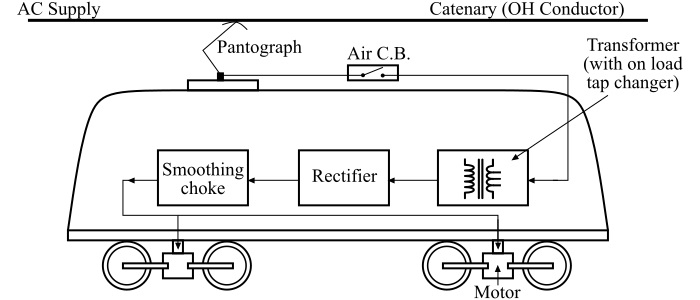
 Data Structure
Data Structure Networking
Networking RDBMS
RDBMS Operating System
Operating System Java
Java MS Excel
MS Excel iOS
iOS HTML
HTML CSS
CSS Android
Android Python
Python C Programming
C Programming C++
C++ C#
C# MongoDB
MongoDB MySQL
MySQL Javascript
Javascript PHP
PHP
- Selected Reading
- UPSC IAS Exams Notes
- Developer's Best Practices
- Questions and Answers
- Effective Resume Writing
- HR Interview Questions
- Computer Glossary
- Who is Who
How do AC locomotives work?
Block Diagram of an AC Locomotive
The following figure shows the block diagram of an AC locomotive.

AC Locomotive - Function of Each Part
The working and function of each part of an AC locomotive is described below −
The AC power at 25 kV is taken from the overhead conductor wire (called as catenary) through a pantograph and this high voltage supply is fed to a step–down transformer (provided with on load tap changer) installed in the locomotive itself, which converts the high voltage AC supply to low voltage AC supply.
This low voltage AC supply obtained from the transformer is then converted into pulsating DC by means of a rectifier.
These pulsations in the DC supply are then removed by the smoothing choke before it is fed to traction DC series motors which are mounted between the wheels of the locomotive.
The air circuit breaker is provided on the top of the locomotive which immediately disconnects the locomotive from the overhead supply in case of any faults in the electrical system.
The step-down transformer is provided with the on load tap changers on HV side. The on-load tap changers are employed to change the voltage across the motors and regulate their speed.
AC Locomotive vs. DC Locomotive
A very significant feature of an AC locomotive in comparison with a DC locomotive is the greater amount of adhesion obtained with AC locomotive. The adhesion coefficient of the AC locomotive is of the order of 30% to 33%. The greater adhesion coefficient is on account of connecting all the DC traction motors in parallel permanently. The speed of these motors is controlled by changing the voltage across each motor by changing the tapping of the transformer on the AC side.
If any motor slips, then in case of AC locomotive, the voltage across other motors is not affected and the adhesion is maintained.
However, there are some drawbacks with AC locomotive such as −
Interference with the neighboring communication lines.
Induced voltage in aerial signaling equipment, etc.
These drawbacks can be overcome by using some remedial devices.

